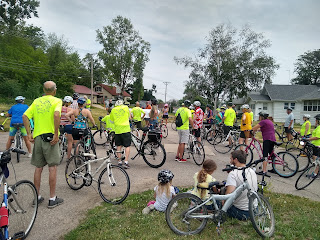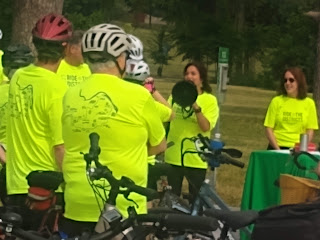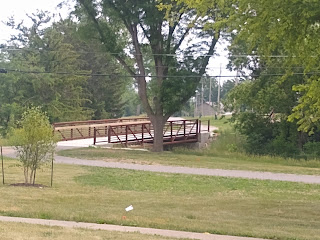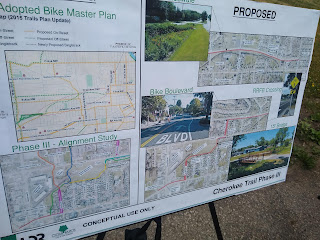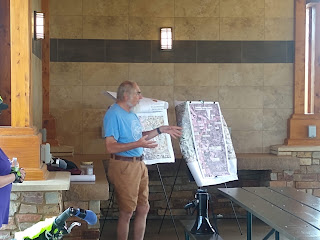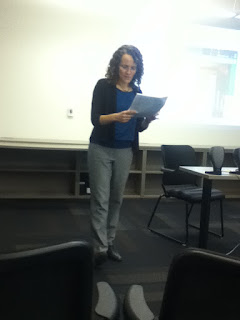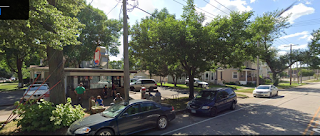[University of Texas students] bristled at the university's $600 annual parking fee. Less parking, to them, meant a more gated campus, an extra fee on top of tuition. They couldn't afford to live in West Campus, the bustling student neighborhood abutting the state capitol building. The question Greg [Anderson] wanted them to ask was not "Why is it so hard to park?" but "Why is it so hard not to drive, to live in a place where you could choose not to care about the cost or availability of parking?" (Grabar 2023: 283)
At an event last night, a woman told people from Matthew 25 how much she liked their recently-established Cultivate Hope Corner Store in Cedar Rapids's near northwest side neighborhood. Her only concern, she said, was they don't provide enough parking for the store to be successful. The comment was well-meant, and well-taken, and reflects that in our town that the vast majority of people will use a car (or, more likely, an SUV or pickup truck) on all trips. Customer parking needs to be plenteous, convenient, and free if any business is going to survive.
It was as though she were tasting a dish--it happened to be a cooking class we were attending--and judging it needed some basil, or maybe just a dash of salt, to liven it up. She's far from alone in Cedar Rapids, and probably in your town as well. But it's time we stopped taking parking for granted, and/or expecting it to be waiting for us whenever we drop by, and started having more informed conversations about what it does to our places. Eighteen years ago, UCLA economist Donald Shoup published his landmark The High Cost of Free Parking, which helped to change the dialogue among city planners, but clearly something more is needed.
 |
| Fast-growing Charlotte has parking craters in the city center |
Into this breach steps Henry Grabar, a reporter for Slate, who has written an accessible, lively and persuasive book on the very subject--how we came to this pass, and what is preventing us from making necessary corrections. Paved Paradise has gotten a lot of well-justified attention, and I anticipate it will raise awareness that parking is not without significant costs. If a few more people in each town stop taking parking for granted, and start noticing its effects, he will have succeeded and probably should be knighted.
 |
| To mollify neighbors, residents of this Charlotte apartment building will be required not to park anywhere nearby |
In part one, Grabar surveys the impact of using land for parking vehicles: higher housing costs and the difficulty of building more, heated sometimes violent conflict when spaces to park are scarce, hollowing out of city centers, loss of historic buildings, more driving and increased traffic volumes, difficult regulation and near-impossible enforcement. He quotes Jane Jacobs towards the end of chapter 4: "The more downtown is broken up and interspersed with parking lots and garages, the duller and deader it becomes in appearance." Later he compares two historical strata in the city of Chicago:
Chicago BP [Before Parking] is the metropolis of the imagination: Art Deco skyscrapers, elevated trains, corner bars nestled inside neighborhoods of three-flats and Victorians, low-slung corridors of uninterrupted commercial storefronts stretching halfway to the state line. Chicago AP [After Parking] looks like run-of-the-mill suburban sprawl: chain stores lurking behind salt-crusted parking lots. (2023: 127)
Part two discusses the administration of parking, both by private enterprises and local governments. Either way, opportunism is rife. Citizens believe parking should be free by right; for parking companies it's an easy way to make money, whether or not there are actual customers; and cities use it both as a source of revenue and an opportunity to grant favors. In chapter 7, he describes in detail the debacle when the City of Chicago sold 75 years of parking rights way too cheaply to a private consortium headed by Morgan Stanley. One good outcome, though: when the consortium (CPM) jacked up parking rates, it increased the supply of available parking as well as encouraging people to try alternative means of getting places like public transit and bikeshare. On the other hand, the city not only has already burned through its windfall, but it is severely constrained in modifying street design for other uses than parking.
 |
| Interior, Arco building, 2022: How will more downtown residents change parking in Cedar Rapids? |
It is in part three where the rubber meets the asphalt. Chapter 8 is a tribute to Shoup, to whom Grabar and all of us are indebted. Then we see the policy changes that Shoup's followers achieved in cities across America: parking meter rates reflecting the demand for parking by time and location, zoning policy changes ending mandated parking minima for new development, no parking requirements near transit, easing parking requirements for accessory dwelling units, among others.
Change is slow to come, though, in part because this is incremental change on top of a parking-rich built environment, and in part because obstacles remain even after the repeal of bad public policies: (1) builders kept building as they always had, (2) downtowns that lacked any alternative to driving, and (3) resistance to reduced parking from (a) current residents, (b) lenders, (c) federal regulations, and (d) tenants themselves (Grabar 2023:213-224). To get along with your development, it's better to go along with the people who can make your life miserable, so putting in excess parking becomes just one of the costs of doing business. Keith Billick found that out the hard way when neighborhood opposition doomed his proposed Lincoln Highway Lofts in 2017 (Kaplan 2017).
 |
| Too close to downtown: Cedar Rapids's blocks-long MedQuarter can be traversed by parking lot--I've done it! |
If I have one complaint about Paved Paradise, it is that Grabar spends most of the book in crowded big city centers. The America that is not New York or Chicago or Los Angeles, but which needs an infusion of good urbanism, gets a nod here but not much else. Parking is a particular challenge in big cities, but it's some kind of a challenge everywhere, just a different challenge. Grabar noted in an interview with the Congress for the New Urbanism today that most American land wasted on parking is in fact in suburbs, which also collectively have the greatest capacity to absorb new residents (assuming we aren't going to pave all the forests and soybean fields). The "valley of high parking requirements" depicted on page 179 probably best describes Cedar Rapids and a lot of similar American communities: land values are not high enough to build a lot of parking garages, but the town can't or doesn't want to build sprawl. (Actually, we can, and do, but shouldn't.) Many of us aren't averse to "more affordable housing, more new businesses, more historic reuse, more walkable neighborhoods," but don't feel like we have to make choices or alter our lifestyles to get them; certainly in the City of Five Seasons, we're not worried about "less time behind the wheel" (2023: 197). Yet, as Grabar notes, even here "Parking-light neighborhoods [are] the hottest neighborhoods in town" (2023: 282). The new condos going up like dandelions in Cedar Rapids' core cost more than my house, reflecting some measure of buyer demand.
The main takeaway from Paved Paradise is that much of local policy towards parking in America has sought to meet citizens' expectations that it be convenient, available, and free or cheap for all, but at best only two of those goals can be achieved. (Grabar, following Shoup, told CNU he'd pick convenient and available, and forego free.) The Cultivate Hope Corner store doesn't need a big parking lot so people from across town can shop there; we need to have more neighborhood corner stores across town. Convincing Americans we can't have it all, and in a supersized pickup to boot, is no easy feat, but this book gets us closer.
INTERVIEW with Henry Grabar on CNU's On the Park Bench series: https://cnu.us10.list-manage.com/track/click?u=0b7f77508e8ddda6a07f50307&id=1ad4652659&e=28c4871ae8
SEE ALSO:
"The Choices Parking Forces," 18 July 2019
"I Wish This Parking Was...," 27 November 2020
Marin Cogan, "The Hidden Force That Shapes Everything Around Us," Vox, 9 May 2023 [interview with Henry Grabar]
Neil Heller and Cary Westerbeck, "Parking Minimums Give Me a Haircut," Strong Towns, 14 July 2020

